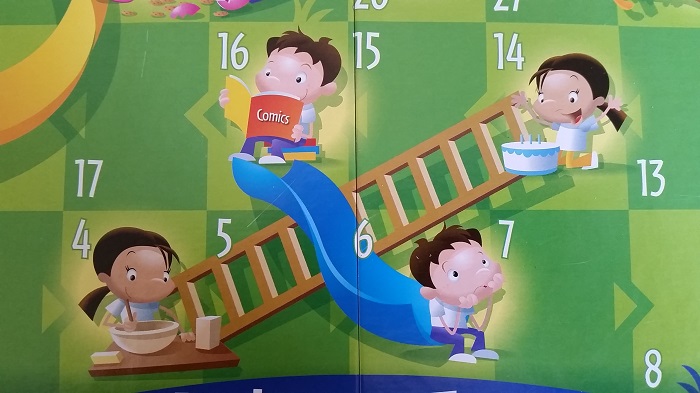
Chutes and Ladders Actions and Consequences
My young kids hate Chutes and Ladders. They hate the complete randomness of spinning that stupid wheel. They hate the complete lack of player agency as there are zero choices to be made. In fact, the game has its origins in teaching children about karma and accepting one’s fate. The modern theming of the board, with artwork of children making good/bad choices before the experiencing the consequences of going up a ladder or down a slide, is completely contradicted by the game’s mechanics. Even very young children recognize they are being bamboozled and quickly lose interest in the game.
CandyLand is a completely random game, completely devoid of player agency. Children take turns drawing color cards and advancing their pieces to the next matching color spaces. Like Chutes and Ladders, candy cards can leap them forward or backward along the path. The games are practically isomorphs of one another, substituting candy and shortcuts for slides and ladders and color cards for a spinning wheel.
Kids LOVE Candyland.
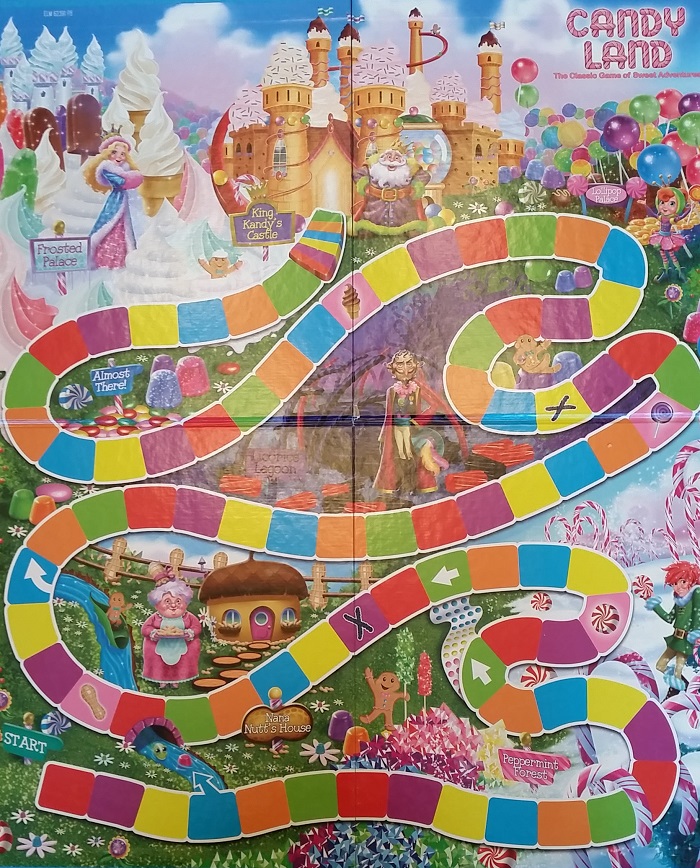
Candyland
Maybe it’s the non-moralizing theme. Candy isn’t judging you. The gingerbread land, candy cane forest, and lollipop castles are just fun. Maybe it’s the lack of math. There are no numbers or addition exercises to make the player aware of how random and tedious this all is. You pick a card and jump to the next spot.
I’m not a fan of Candyland, but I am a fan of playing with my kids. So I look for opportunities to engage with them where and when I find them engaged. With Candyland, I have a lot of time to think about how to better engage with my kids. In The Well-Played Game, Bernard DeKoven proposes game players think more like game designers, taking ownership of the games they play and their rules:
You’re not changing the game for the sake of changing it. You’re changing it for the sake of finding a game that works.
Once this freedom is established, once we have established why we want to change a game and how we go about it, a remarkable thing happens to us: We become the authorities.
No matter what game we create, no matter how well we are able to play it, it is our game, and we can change it when we need to. We don’t need permission or approval from anyone outside our community. We play our games as we see fit. Which means that now we have at our disposal the means whereby we can always fit the game to the way we want to play.
This is an incredible freedom, a freedom that does more than any game can, a freedom with which we nurture the play community. The search for the well-played game is what holds the community together. But the freedom to change the game is what gives the community its power.
Taking ownership of Candyland, I’ve come up with the following mechanics to both increase player agency and also teach my kids some of the options for taking ownership of their own play.
1. Push-Your-Luck
A very simple tweak to the game. After drawing their initial card, players may choose to pull a second card, but must accept the second. Adding just this minor bit of player agency dramatically increased my young play testers’ engagement with the game.
2. Gallery
Inspired by the delightful print-and-play card game Bear Went Over the Mountain. For this variation, set out five cards face-up. Each player gets three coins or poker chips. On their turn, they draw a card, and then they may spend one coin each turn to buy and play a gallery card in (a) addition to their pulled card or (b) instead of their pulled card.
The first time we played this, the purple lollipop came out in the gallery, which takes you the furthest you can go in the game on a first move. My four-year-old, the youngest, immediately claimed this card. This caused my six-year-old to shriek, “No fair!!!” and threaten to quit the game.
After calming him down and assuring him there would be more good cards coming up in the gallery, I realized the problem with this mechanic the way it was set up: the rest of the cards in the gallery sucked and the choices would only get worse as all the good cards got bought up. So we added another rule: if the active player doesn’t like any of the cards in the current gallery, they may ask for five new cards to replace it one time. Thus candy cards and double moves came up every refresh and everyone was happy–especially Daddy since games finished very quickly.
3. Gallery with Bidding
Like above, but a player may place a poker chip from a starting set of chips, say five, on any card at any time. The player with the most chips on a card may claim it as their move if no one out-bids them.
4. Hop or Bump
Hop: If a player lands on the same spot as another, they jump to the next unoccupied spot of that color. Bump: If a player lands on the same spot as another, they bump the other player backwards to the nearest candy or start of the board if no candies. Hop or Bump: the player may choose whether to hop or to bump to add more strategy.
5. Hand Size
Players each get a hand of five cards from which to play, for simple forward-thinking. Draw a new card at the end of each turn. Combine this with the “Hop or Bump” mechanic for a fun game. Return to this mechanic after the players have some experience with the “programming” mechanics.
6. Last-Player-Standing
Instead of racing to be the first, turn the game upside down by seeing who can be the last to reach the end.
7. Victory Points
Combined with a gallery and/or hand-size, have players choose a subset of the trophies below and point-values for each trophy. This can be done by voting or by turn-taking. This way the game-setup becomes part of the strategy as well:
- First, second, last place.
- Most [color], doubles, candies, cards.
- Most hops/bumps.
- Fewest cards (shortest route).
Once again, this mechanic comes from the free print-and-play game Bear Went Over the Mountain, which has a wonderful theme and gameplay. So maybe just play that instead.
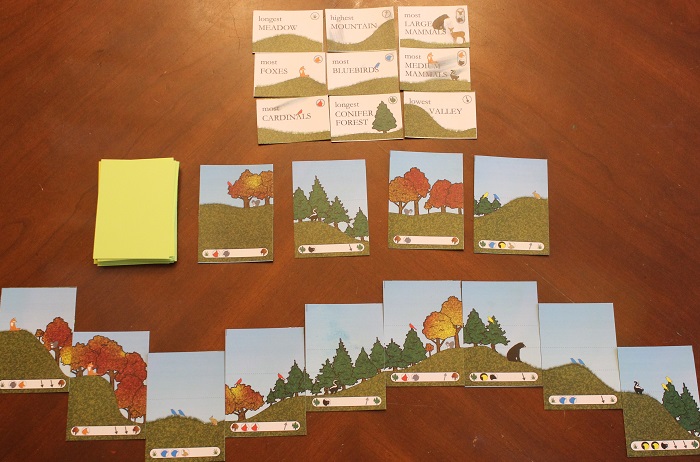
Bear Went Over the Mountain
8. Programming – Basic
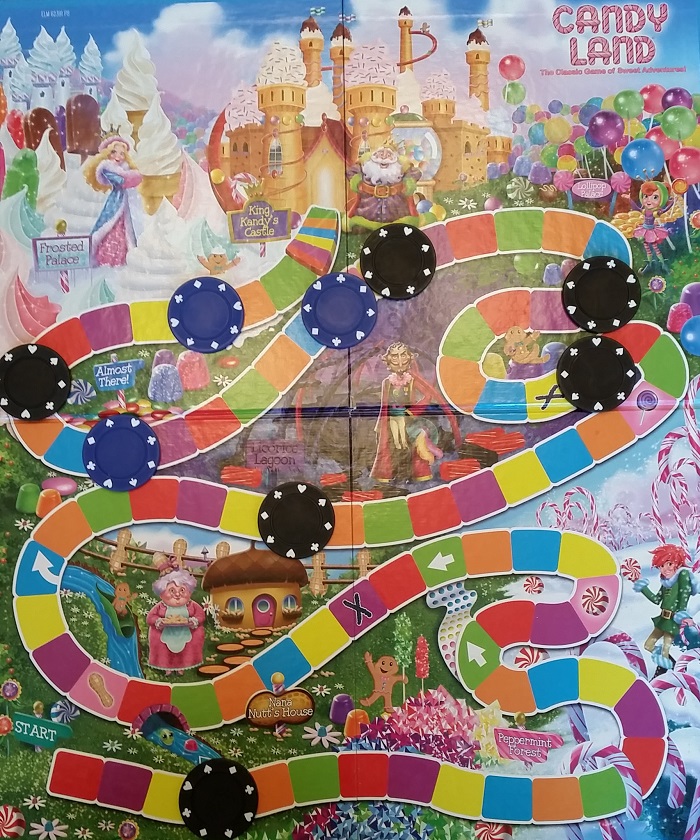
Programming Candyland
Each player gets 10 cards and three-to-five minutes to plan out their moves to get to the castle. They may place poker chips of their assigned color on the board to visualize and plan out their moves. The player who gets to the castle in the fewest moves wins.
9. Programming – Advanced
Like above, but the players must plan out all their moves in their head and and sort their cards accordingly. Then, like Roborally, take turns flipping over cards until someone wins.
10. Cooperative Play
Kids don’t like to lose. Young kids especially don’t like to lose. Young kids playing competitively against their parents often won’t even attempt the game because they see it as so unfair. So a cooperative variation on Candyland is a must-have.
I struggled with this one. A good variation I came up with was having all players reach the end at the same time. This wasn’t too difficult in a two-player scenario and five-card hands. My son got way ahead of me, but slowed down at the last two bends so I could catch up. For more players, a card-trading mechanic, where players can swap cards to improve their odds even more, could make the experience less intimidating.
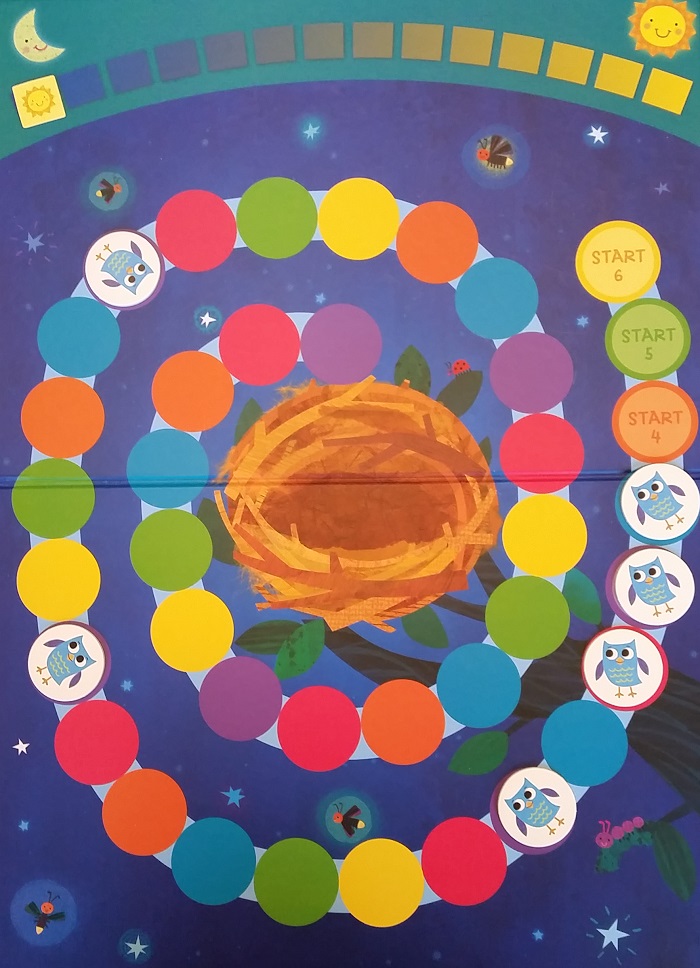
Hoot Owl Hoot
A much better version I discovered recently is to simply rip-off the game Hoot Owl Hoot, where players can move any piece on the board and are working to get all the gingerbread men to the goal in a certain number of moves. The difficulty level can be set by adding/removing the number of gingerbread men or increasing/reducing the number of moves allowed. You can even add a monster to the board, threatening to devour any gingerbread men that fall behind.
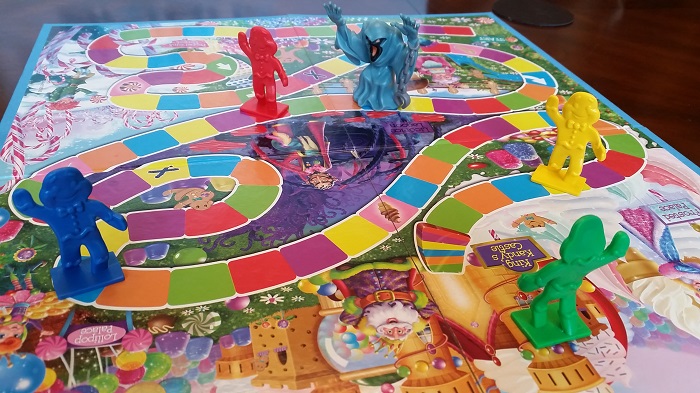
Monster Chasing the Gingerbread Men
Or you could just buy Hoot Owl Hoot. It’s a great game that requires a good deal of strategy to beat on difficult levels. The game plays in such a way as to encourage children to make strategic plays, like saying “Hoot!” when hopping pieces.
Conclusion
Chutes and Ladders is a purely random game, completely devoid of player agency. So is Candyland, but replacing numbers and a spinner with cards and colors are theme modifications that get kids to enjoy one over the other. While the games are the same, Candyland’s playing pieces allow for experimenting with the rules. You can make a lot of different games from Candyland’s components.
Just as Bernard DeKoven argues, when we exercise our freedom to hack the rules of a game, we become the game designers. We can dramatically increase player agency. We can garner deeper strategic insights by changing the rules and seeing how things play out. Most of all, with gaming literacy, we can apply a world library of game-mechanic toolkits to make more enjoyable games and show other how to do the same.